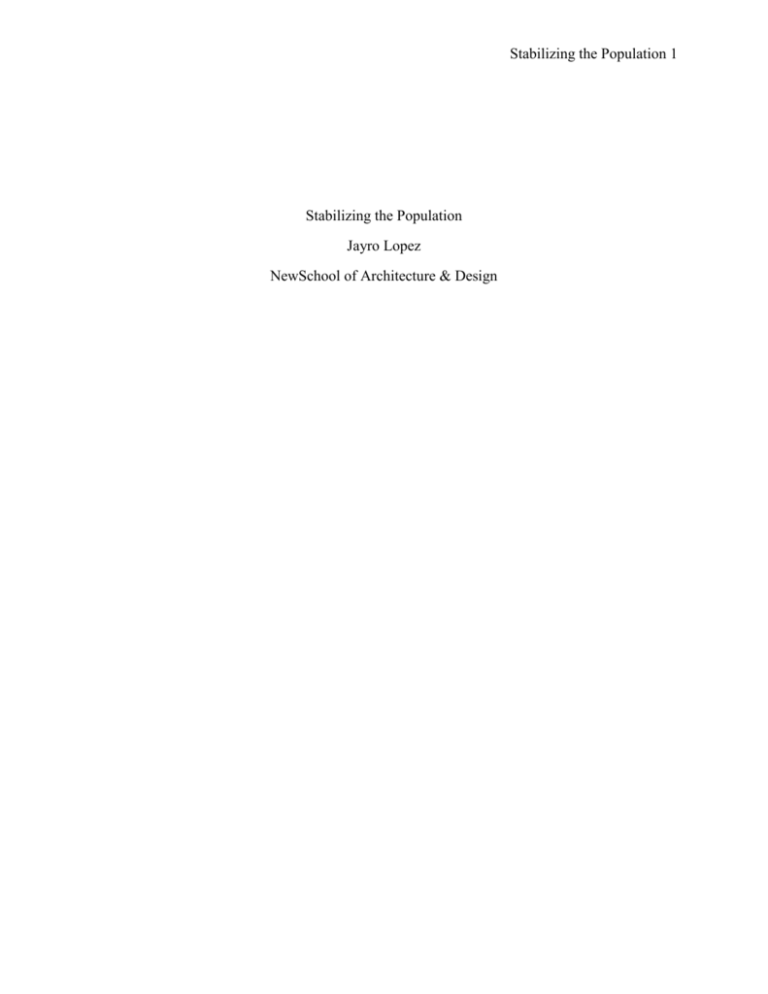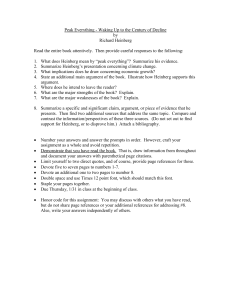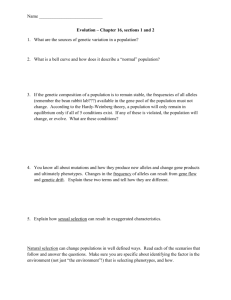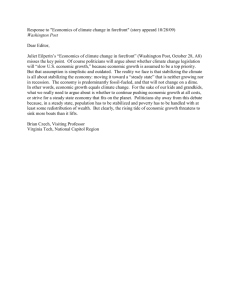Population - WordPress.com
advertisement

Stabilizing the Population 1 Stabilizing the Population Jayro Lopez NewSchool of Architecture & Design Stabilizing the Population 2 Abstract The ever-increasing population of humans on Earth has historically been deemed a good thing: a good thing for humanity, for the survival of our species and for the continued growth of our economy. What we are beginning to realize is that we are living on a planet of finite resources and we are on a pace to run out of resources to continue the same standard of living that we have now. It’s not only the most commonly discussed resources like oil, but also the most basic and essential nutrient to all of life; water. Disputes and even war over resources as simple as water are not a question of if they will happen, but when. The stabilization of the population is vital to the survival of our species as we are on a collision course between an unsustainable population size and finite resources. Fortunately there are solutions available at our disposal to deal with the looming population crises and some nations have already taken it upon themselves to find solutions for issues that haven’t surface yet but are beginning to prepare for. Stabilizing the Population 3 Stabilizing the Population One of the most important, yet overlooked looming crises of our time will be the population of humans on this planet; it is a sensitive topic that is often overlooked and ignored. On both sides of the political spectrum any talk of population control is faced with strong opposition; on the left, it is seen as a humanitarian rights violation and on the right, it is seen as detrimental to economic growth. The main reason for our huge increase in population is not because our birth rates are increasing, in fact they are lowering, it is because the death rate has declined (Heinberg, 2010). This is due to many positive things, like higher food production, advancement in medicine and finally we are becoming an even more civilized population, even if it doesn’t seem like it at times, by producing fewer wars with even lower number of casualties. By the start of the industrial revolution or by around the end of the 18th century, we had barely reach our first billion in population as a species after 200,000 years or so of existence (Heinberg, 2010, p. 155). It only took us around 200 years to reach 5 billion more and only 12 more years to reach an additional billion. We are on pace to reach 9 billion people by the year 2050 (Lehmann, 2010, p. 155). Years Elapsed 3,000,000 10,000 1,600 200 130 30 15 12 12 12 Year 10,000 BC (Agricultural Revolution) AD 1 ~1600 ~1800 (Industrial Revolution) 1930 1960 1975 1987 1999 2011 (Heinberg, 2010, p. 155) Approximate Population 5-10 million 170 million 500 million 1 billion 2 billion 3 billion 4 billion 5 billion 6 billion 7 billion What can we attribute to this rapid increase in population? And what can we expect as a Stabilizing the Population 4 consequence to the added stress into our world from this? The population increase that we are experiencing now all started as recently as the 1920s. It can be attributed to from declining birth rates, which are the result of widespread vaccination programs and other public health measures (Heinberg, 2010, p.155). Child survival rates have had a huge impact on population growth. The industrialized world has high child survival rates and low babies per women, around 2. The climate impact of not having an extra child is almost twenty times more important to the environment than any environmentally sensitive practices people might employ in their lives: things like driving a hybrid vehicle, being vegan, recycling, or using energyefficient appliances and light bulbs (Murtaugh, 2009). When child mortality rates are high, then there is an increase in babies per woman. And with the increase in child survival through things like vaccinations and better healthcare, the poorest billion still have a child survival rate of up to “70 to 80 percent, meaning that if you have six children born, there will be at least four who survive to the next generation. And the population will double in one generation” (Rosling, 2010). An increase of child survival will influence families to have smaller families. So the only way of really getting world population [growth] to stop is to continue to improve child survival to 90 percent. That's why investments by Gates Foundation, UNICEF and aid organizations, together with national government in the poorest countries, are so good; because they are actually helping us to reach a sustainable population size of the world. We can stop at nine billion if we do the right things. Child survival is the new green. It's only by child survival that we will stop population growth. (Rosling, 2010) Stabilizing the Population 5 There’s all of this dramatic population increase but so what? How will this affect everyday people and why should they and the nations of the world be concerned? The simplest concept to understand is that we simply do no have enough resources to support the projected population of 2100 if there are no actions taken by nations and families. There is a finite amount of resources available on the planet. There is a lot of talk about the oil peak but the talk of the earth running out of usable fresh water is largely ignored and has only recently started receiving strong attention like in California, which is currently experiencing a severe drought. Freshwater only makes up about 3 percent of all water on earth and “there will be scarcely one fourth as much fresh water per person in 2050 as there was in 1950… Indeed, spreading water scarcity may be the most underrated resource issue in the world today” (Heinberg, 2010, p. 160). We haven’t solved the feeding crises that occur now with our current population, so feeding the increase in population will also be a great challenge. The increase in energy use by caused by the increase in population will also be tremendous challenge. There must be dramatic steps to find alternatives to lower our dependence on fossil fuels. We are near the point where we reach peak oil, and when this occurs there will be huge energy crises on this planet. “The inability to continue increasing oil production to support continued economic growth would lead to much higher prices for oil, which in turn would stifle both economic growth and the demand for oil” (Heinberg, 2010, p. 251). “The eminent scientists of the Global Footprint Network, for example, calculate that we need about 1.5 Earths to sustain this economy” (Gilding, 2012). The evidence for climate change due to the dramatic increase in population is everywhere. The higher the population the higher the CO2 levels in the air, which in turn affects the world climate. The developing nations of the world want the standard of living of the industrialized nations, meaning a comfortable home that will include heating and cooling, Stabilizing the Population 6 running water, the latest electronics and a car in the garage (Heinberg, 2010). The United States did an excellent job of spreading capitalism and the American dream but it is not a sustainable model for the rest of the world or even the United States to continue due to the increase in population and the amount of resources required to support that lifestyle. We can do many things right to help stabilize the population but without proper family planning we will fall short of that goal. Family planning will play a huge role in stabilizing the populations of humans by educating families about their options. Women in particular need to be educated. Babies per woman decrease when: 1. Children Survive 2. Many children are not needed for work 3. Women are educated and enter the labor force 4. Family planning is accessible Women when given the opportunity prefer to become educated and enter the labor force, which in turn encourages them delay childbearing. “The scholars and experts in the government agency in Qatar, and they say the most important factors are: "Increased age at first marriage, increased educational level of Qatari woman and more women integrated in the labor force” (Rosling, 2012). We can stabilize the population in the world. The magic number will be somewhere between 9 to 10 billion people. We have the capability to produce enough food for 9 billion people and sustain it on this planet but only if we gradually increase the population and plan accordingly and prudently for the increase. “The top three countries for population growth are India, China, and the United States. India grows by about 17 million per year, China by about 7 Stabilizing the Population 7 million per year, and the United States by about 3 million per year” (Heinberg, 2010, p. 154). As a species we have actually reached what is called “peak child”. Peak Child is where we are no longer procreating children at higher than equal replacement (Rosling, 2012). And this is encouraging news because that means we have a solid way to begin to stabilize the population size. This will eventually lead to what is called “The Great Fill Up”. The Great Fill Up is when we reach “peak child” and the old simply die at the rate of replacement, essentially stabilizing our population (Rosling, 2012). This however, is not a guarantee. Unless we take conscious and sincere actions now we will not be able to prevent complete disaster. Despite the commonly held belief that religion will be an obstacle that will cause much trouble when trying to implement family planning, there are plenty of examples out there where this belief is proven wrong. The Catholic Church supports sexual education and encourages couples to limit the number of children that they procreate, “limiting family size and curbing population growth rates have already proved possible in Catholic and Islamic Countries” (Heinberg, 2010, p. 166). Religion has nothing to do with population growth (Rosling, 2012). But small families need to be highly encouraged and become the norm in our society. The belief that more economic development will decrease birth rates is untrue. Child survival rates and family planning do despite the economic development of a nation. Families of the poorest nations and the developing countries do however need to be brought out of poverty to increase child survival rates so that they family will be less tempted to procreate above replacement. According to Les Knight, the founder of the Voluntary Human Extinction Movement, “No virus could ever get all 6 billion of us,” he also states “War doesn’t work either. Millions have died in wars, and yet human families continue to increase. Most of the time, wars encourage winner and losers to repopulate” (Weisman, 2007, p.310). He also proposes gently Stabilizing the Population 8 laying the human race to rest. Obviously this is an extreme viewpoint and would never be feasible. Some solutions to help stabilize the population are quite ambitious. We require the same type of prudence and intensity that we have achieved before during exigent times, like war. During WWII we were able to restructure our entire manufacturing industry into producing the equipment possible for war across two different ocean, for example we were able to ban the sale of cars for 3 years in the US and in its place airplanes were produced (Brown, 2008). There is an incredible challenge ahead of us, but the good news is that we are fully capable of solving it with technologies that already exist today. Many are at the forefront of our technological advancements like the highly efficient wind turbines in Europe where they have reduced their dependence on fossils fuels for electricity; and the heating of Iceland homes by geothermal energy; to the simpler, technologically speaking, solution of having 40 percent of all trips taken within a city by bicycle in a city like Amsterdam (Brown, 2008, p. 22). What research has been trending is that we are well on our way to a population of 9 billion by the year 2050 despite some of our best efforts to prevent this. But there may not be a need to do anything drastic or dramatic like the Chinese have to prevent the eventual increase as long as we take action now. The key to decreasing the babies per woman are simple: you increase child survival rates, decrease the amount of children needed for work, educate woman and allow them to enter the work force, and make family planning accessible and a priority. The consequences for and imbalanced population on earth are far too great to ignore any longer. This topic is too important to avoid just because it is controversial. We can no longer pretend that this isn’t and issue or argue that any discussions about population stabilization is some sort of human rights violation like seeking to reduce the number of people of color or as the favoring of Stabilizing the Population 9 abortions (Heinberg, 2010, p. 154). The population has already had a huge impact on climate change. The real question isn’t whether or not the planet will survive humans, because the earth will survive and reach equilibrium with itself despite the changes we have done to it, but whether or not we will have a planet that we can survive on comfortably and without catastrophe. Stabilizing the Population 10 References 1. Gilding, P. (2012). The Earth is Full. [video] Available at: http://www.ted.com/talks/paul_gilding_the_earth_is_full?utm_campaign=iosshare&utm_medium=social&source=email&utm_source=email [Accessed 5 Nov. 2014]. (Gilding, 2012) 2. Heinberg, R. (2010). Population: The Multiplier of Everything Else. In The Post Carbon Reader: Managing The 21st Century's Sustainability Crises (pp. 153 - 174). Healdsburg, Calif.: Watershed Media ;. (Heinberg, 2010) 3. Brown, L., & Brown, L. (2008). Plan B 3.0: Mobilizing to Save Civilization. New York: W.W. Norton. (Brown, 2008) 4. Weisman, A. (2007). The World Without Us (pp. 291-92, 310, 349-52,). New York: Thomas Dunne Books/St. Martin's Press. (Weisman, 2007) 5. Lehmann, S. (2010). The Principles Of Green Urbanism: Transforming The City For Sustainability (p. 155, 730, 748). London: Earthscan. (Lehmann, 2010) 6. Mars, N., & Hornsby, A. (2008). The Chinese dream: A society under construction (pp. 100-01, 563, 645-46). Rotterdam: 010. (Mars, 2008) Stabilizing the Population 11 7. Rosling, H. (2010). Global Population Growth, Box By Box. [online] Ted.com. Available at: https://www.ted.com/talks/hans_rosling_on_global_population_growth [Accessed 2 Nov. 2014]. (Rosling, 2010) 8. Rosling, H (2012). Religions and Babies. [video] Available at: https://www.ted.com/talks/hans_rosling_religions_and_babies [Accessed 2 Nov. 2014]. (Rosling, 2012) 9. Murtaugh, P., & Schlax, M. (2009). Reproduction And The Carbon Legacies Of Individuals. Global Environmental Change, 14-20. (Murtaugh, 2009) 10. Ramankutty, N., Foley, J., & Olejniczak, N. (2001). People on the Land: Changes in Global Population and Croplands during the 20th Century. AMBIO: A Journal of the Human Environment, 251-251.







